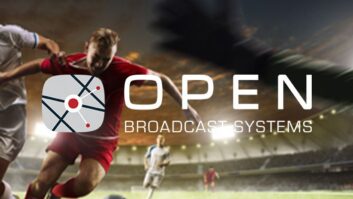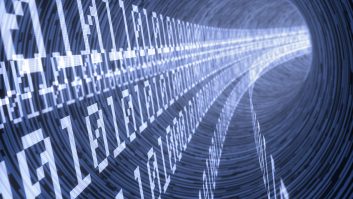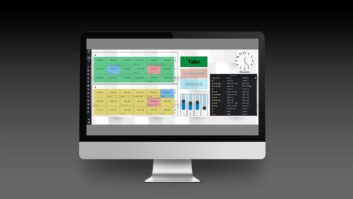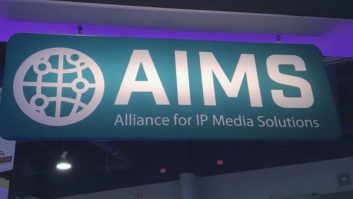Any engineer who has worked in broadcast systems in the last 20 years will have at some point configured an IP address. Understanding the logic behind the numbers entered as part of that address, and what mechanisms are in place, are becoming as important to broadcast as understanding how signals travelling down wires represent audio and video signals.
Until recently, all most broadcast engineers needed to worry about was ‘baseband’ signals (a term with many varied meanings but generally referring to real-time signals carried in an uncompressed form over dedicated wires – e.g. SDI or Analogue/AES3 Audio). Modulated RF and compressed/multiplexed signals were the domain of specialist teams – much like the computer and networking hardware that has been powering post production systems were supported, in part, by dedicated IT teams.
With the move away from centralised SDI routing infrastructures, those uncompressed signals are now being carried as packets of IP data over complex networks. In order to diagnose connectivity issues, engineers can no longer trace signals flowing down coaxial cables but instead need to embrace a new set of tools providing visibility of what data is flowing down the shared pipes between network switches and routers.
Now that’s not to say that all engineers need to be enrolled on Cisco CCNA training. On the contrary, that sort of education is generally only needed for those specialist Network Engineers who will directly configure and administer the networks. Broadcast engineers need to ‘know what they don’t know’ enough to appreciate the design choices being made by the specialist network designers. Broadcast engineering teams should be given appropriate access to interface with the networked systems, this may include the full ability to make architectural changes as the nature of issues in a broadcast setting often demands engineers are empowered to ‘do what needs to be done’ – though in most cases, strict change management processes are essential which will allow time for the specialists to get involved and ultimately call the shots.
So back to IP media training – the world of standards published by SMPTE and others has always been a complex landscape. People can build their knowledge about standards through reading them (or being trained by someone who has), but to properly understand them people need hands-on experience, or at least to see real systems in action, especially ones which have issues. Engineers truly learn by solving problems – that’s why the older generation of engineers are so valued – they’ve seen so many things break and have been involved in figuring out how to fix them. Nobody wants to face issues in their day-to-day work, but when they do occur, confident engineers who have some basic knowledge of how systems interoperate will do their best to poke and prod until something they do makes the situation better. Over time, engineers learn what poking and prodding has the best effect and some may fully square the circle in understanding exactly why an issue occurred and was resolved.
So, don’t expect any training course to be a silver bullet that magically makes engineering teams able to support the new systems being built – but it is an important part of the journey to knowledge. Exposure to real systems and discussions between colleagues willing to openly share experiences are even more important – opportunities for this internally within companies is given (though sadly not always prioritised). External groups such as SMPTE UK promote engagement and discussion between colleagues from across the industry and should be encouraged and supported, as often a little bit of insight or a new perspective can be the key to solving long-open issues.
Changing gears a bit to talk a bit more about my experience through Q3 Media Training. I’ve personally delivered our standard IP Media Networks course well over 20 times now, as well as some variants based upon it. No two courses have ever been exactly the same as I keep learning more and more – both from the SMPTE standards, which keep evolving, but also from the questions and discussions I have with people through the training. Even the so-called ‘experts’ in the field are still learning. How different manufacturers implement things varies significantly and making sense of it all can be a real challenge. The IP rack in our #BigPinkDemoKit has IP Media systems (2110/PTP/NMOS) from 10+ different vendors and can demonstrate both the good and the bad. Understanding the cause of the bad behaviours has been a struggle – but one that has lead to a better understanding of what’s actually going on inside the devices and the networks.
From a general training point of view we see a wide range of clients, from those who are willing to invest in giving their staff the grounding that will lay the foundation for further learning, to those with more unrealistic expectations as to what can be achieved by a short course. We aim to pack a lot into our training sessions as the concept of ‘know what you don’t know’ is our number one belief as to what makes a great engineer. All our sessions are recorded, and we hear from some how useful it is to re-visit the topics we covered at a later date, possibly with hindsight of a recent project or operational discussion. Learning is a continuous process. SMPTE’s free access to self-paced learning online is hugely valuable to the industry. It complements the training that we provide by giving people similar information presented in a different way. With complex topics like IP, the more content that people have access to, the better it becomes for everyone.
The archive of presentations on https://ipshowcase.org/ is also a great place to get both introductory level and deeper dives into all the topics relevant in the IP media world right now.







